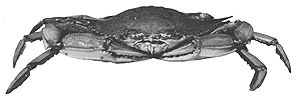

". . . A faire Bay compassed but for the mouth with fruitful and delightsome land. Within is a country that may have more prerogative over the most pleasant places of Europe, Asia, or America, for large and pleasant navigable rivers. Heaven and earth never agreed better to frame a place for a man's habitation." -Captain John Smith
First explored by Captain John Smith in 1608, the Chesapeake Bay is "a great arm of the sea that thrusts nearly two hundred miles deep into the fertile lowlands of Maryland and Virginia." (Wheatley 1973) Home to diamondback terrapins, egrets, striped bass, menhaden, shad, bluefish, croaker, and the world's largest natural bed of oysters, the Bay is also home to Callinectes sapidus - the "savory, beautiful swimmer." "Amongst the fastest swimming of crabs, and one of the world's most succulent," the watermen of the Bay area have not always sold these crabs to the market, but they have spent generations catching, eating, and developing new techniques and gear. (Wheatley 1973) For many families and communities of the Chesapeake Bay, this estuary has been the source of their food, enjoyment, economic livelihood, and culture for centuries.
The continent's largest estuary, the Bay has a combined shoreline of nearly 4,000 miles - a distance equivalent to crossing the country at its widest point. (Warner 1994) A well-enclosed body of water, with easy entry and exit for open sea water, and vigorous infusion of fresh water from one or more rivers, the Bay meets the minimum requirements for estuary status. However, to achieve high biological productivity, an estuary must have other elements, all of which are met by the rich and astounding Chesapeake Bay: 1) shallow water to nourish plankton and plants with sunlight, 2) extensive marshland to trap nutrients and protect and feed fish and invertebrates, and 3) good circulation - horizontal circulation and vertical mixing created by contrasts in depth and water temperature. Aware of this ideal environment, the blue crab of the Chesapeake basks in the sunlight that shines through its shallow waters, hides in its succulent eelgrass for protection, and enjoys the warmth of its deeper waters in autumn. (Warner 1994) Some believe, that "throughout the length and breadth of the Chesapeake, the heartland of crabdom, no place is more ideally situated for soft crabbing than Smith Island." Therefore, it is no suprise that after 140 years of commercial crabbing in the Chesapeake, the communities and individuals of this area created and have now grown used to a lifestyle like no other.
Known as "jimmies" (legal-size males), "she-crabs" (immature females), "peelers" (crabs about to shed their exoskeleton), and "sooks" (mature females) by the watermen of the Bay (Wheatley 1973), the blue crab "ranges from Canada to South America and is abundant from New Jersey to Texas; but more than half of our commercial catch comes from the 180-mile-long Chesapeake." (Horton 1996) Not surprisingly, the U.S. is the leading crab-consuming nation of the world with annual catches that range from 250 to 350 million "whole crab" pounds - equivalent to $80,000,000 in sales. The fourth most valuable fishery (preceded by shrimp, salmon, and tuna), the blue crab makes up 50% of the total crab catch of the nation. Half of the total catch of the blue crab species is caught in the Chesapeake, including 95%-100% of the soft (i.e. molted) crab national catch. (Warner 1994)
If any one word had to be used to describe the Chesapeake Bay, "unique" might be the best candidate. Already proven to have a unique abundance of blue crabs by astounding figures concerning catch and consumption, the crab fishery of the Bay has produced two other unique qualities over the years: 1) the isolated and continued use of the term "watermen" and 2) the evolvement of special small craft that has enabled watermen to better harvest oysters as well as to reach the tight, shallow places in the water that crabs most like to inhabit.
The crabbing industry involves a lifestyle, an environment, and even a language all its own. Days that begin at 3:15 am and end when the sun gets too hot to stand, knowledge that takes decades to absorb, and patience that is hard to come by elsewhere. "Only those who acquire the smart of it and follow it strong may get by." (Warner 1994) After 140 years of commercially harvesting blue crabs from the Chesapeake Bay, the "beautiful swimmer" is still "holding its own" while nearly all other commercially fished species of the Bay are experiencing steady declines of dangerous levels. (Warner 1994)
However, even the blue crab has factors working against it: 1) reduced beds of eelgrass, used by crabs and other marine organisms for hiding and nursing their young, by 70%-90% from the 1970's, 2) watermen shifting away from harvesting the declining stocks of oysters towards concentrating on "the blue crab as their principal (or only) means of support", and 3) an increase in work load in order to harvest the same amount of blue crabs as in the 1970's. (Warner 1994) The major source of these problems is the result of a large increase in population size: "fifty million people now live in the Bay's vast watershed, a rise of fifty percent since the late 1950's." (Warner 1994)
There is, however, hope for the blue crab for both Maryland and Virginia are presently considering implementing limits on the blue crab catch and, if imposed, "would mark the first time in the Bay's history that conservation measures have taken place before a marine resource was depleted."(Warner 1994)